Our Funded ProjectsIoTStyring
OJ invest in innovation. We are passionate about creating optimised solutions for our customers using our know-how and vast experience within our field of knowledge. Therefore, being Lead Partner of this project was only a natural step in gaining a clear vision of next generation technology.
Internet of Things (IoT) implies unique identification of objects and their virtual representation on the internet. IoT and connected technologies of digitalisation create new opportunities and demands amongst others within building automation, utility services, and industrial production.
Control systems can be operated through the cloud, and users as well as manufactures of devices get extended opportunities for interaction with their equipment.
Devices and control systems can more easily be part of Smart Grid / Micro Grid balancing of production and consumption on the electrical grid. Furthermore, new opportunities arise for collection and analysis of data. For instance, regarding patterns in user behavior, which creates basis for automated and need based user adaptation. Combined with improved facilities for user control it increases the possibilities for energy efficiency and improved comfort.
Meanwhile, the application of IoT digitalisation technology also creates new needs. Technology for critical communication and interoperability is therefore also at focus in the project.
“The IoTStyring project has been a boost for OJ Electronics in regard to accelerating our development of IoT based cloud systems and product. We have increased our competences and knowledge especially in relations to designing and building a cloud system for IoT products and in relations to selecting the right wireless technologies for our devices. OJ now has a clearer vision for how to utilize machine learning in next generations of our products”.
Finn Kähler, Software Manager, OJ Electronics
Energy efficiency with IoTThe purpose of the project
The objective of the project IoTStyring is, on basis of digitalisation technologies, to develop, test and document an innovative management concept for energy-efficient and comprehensive management of floor heating, ventilation, and lighting, all in one. Furthermore, the user experience improves when the control becomes more precise in relation to the needs. The concept applies an infrastructure for secure data communication. The innovative concept is tested and documented using a demonstrator.
The goal of the project
The IoT management concept is linked to and exploits the increasing demand for Internet-connected products and solutions.
The concept makes it possible through the Internet to connect, integrate and control systems of different types of devices. The goal is to provide a more energy-efficient and user-optimized operation through a flexible and easy integration of several devices and the control and regulation of different subsystems. IoTStyring creates the opportunity for a user-friendly automation system located in the cloud, which provides significant energy savings through automatic user-adapted regulation.
The outcome
Through the IoTStyring innovation effort, the companies have strengthened their product development, and they have expanded their competencies within this field.
Intensive technical efforts have been made related to connectivity, interoperability, customised control, and automation systems located in the cloud. This has produced new knowledge and skills targeted at key elements that are a prerequisite for the development of new IoTStyring concepts.
Workshops and discussions between the companies has been conducted related to the overall analysis of industrial trends regarding technologies and products related to IoT solutions. A vision has been developed for the IoT Control concept. Along with this, steps have been taken towards which usage scenarios are relevant in an IoT Control system, and towards which business models should be utilised to create further business based on IoT.
Regarding the business models, especially discussions related to transitioning from a more product-based business towards a more “product as a service” oriented business has been in focus.
The challenge in this work was to find common ground amongst the companies, since they are very different both in domain, business and organisation.
Creating connectivity is one of the main challenges in IoT. The Internet of Things is, as the name suggests, an ambiguous term with many different applications, as it involves everything.
In the IoTStyring project, the use cases explored mostly involved in building communication, with short ranged wireless connectivity and wired connectivity. This was done as most of the project partners’ core business are products that are located in buildings and often only need communication from one room to the next room.
The chosen technologies for the work package 2 were:
Wireless connectivity technologies:
- Bluetooth Low Energy (BLE)
- Wi-Fi
- NB-IoT
Wired connectivity technologies:
- KNX
- ModBus
- BACnet
From these technologies, BLE, Wi-Fi, KNX, ModBus and BACnet was successfully implemented and used in the project. The use cases of NB-IoT was found to be out of scope of the project.
The project has prototyped solutions for the integration of various IoT devices and building systems.
The design includes gateways for communicating with the different sensors and building systems utilising different communication protocols. The infrastructure enables interoperability between the different gateways to enable new ways of IoT-based collaborative control.
The project has developed several concepts for how to provide user-control of building infrastructures based on IoT technology. This includes smartphone app concepts for providing inputs and configuring IoT devices. Another track is machine learning models for predicting conditions to improve the control of buildings to provide better indoor conditions for occupants. These technologies are based on using data about users which have inspired the project partners to work on methods to protect the privacy of users. These results have also been documented in scientific publications.
We have analysed the needs in context of designing a cloud solution that is flexible enough to support integration of the different products from the project partners and others IoT based products. Different technologies and hosting platforms have been evaluated.
A major challenge was to design a system flexible enough to support integration of the wide variety of products with very different interfaces based on different technologies. A solution has been designed and implemented based on OPC UA for integration of products and using Apache Kafka as the infrastructure for streaming messages internally between services in the cloud.
Initial prototype of the cloud system has been developed using python. System has been transitioned to C# in order to support better scalability on cloud hosting platforms (Azure + Docker).
The project has evaluated the developed solutions and technologies in several demonstrations. For building control, the demonstration activities have focused on evaluating developed concepts with current and up-coming products of the participating companies. The concepts and products have been integrated and deployed for testing. The trials have been documented with project videos to communicate ideas and their concrete form among the project partners and their employees.
“We are very grateful for participating in the IoTStyings-project. The project has been a real eyeopener showing us the exciting possibilities IoT has in the critical coms industry, even if the technology still is in its infancy. During the project we have looked into new technologies, researching innovative solutions to the stale PMR industry, which has opened up new business strategies.”
Hauke Holm, Vice President – R&D, Damm Cellular Systems A/S
”SDU have inspired the companies with novel software technologies for their future products. The project has provided SDU with input on IoT challenges that can inspire future research”
Professor Mikkel Baun Kjærgaard, University of Southern Denmark
“The IoT Control project has been a learning case for Automatic Syd in regards to learn about IoT components based on data exchange to cloud systems. We have increased our competences and knowledge especially in relations to how difficult it is to design and build components who can produce data for a cloud system and in the same time be an integrated part of their own solution. For us as consumer of data from IoT components it has been very educating to be part of this project.”
Niels Laursen, Teknisk-leder Automation / Solution Manager Automation, Automatik Syd







